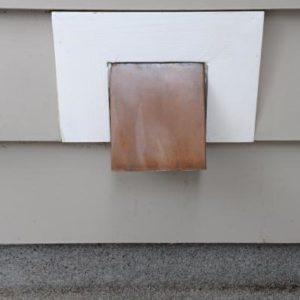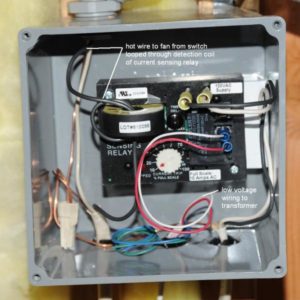How to Set Up a Dampered Fresh Air Intake

With houses in general becoming tighter from an air leakage standpoint, and more and more homeowners installing high heat cooktops and ranges (hopefully with high-capacity exhausts), the need for dampered outside air intakes has never been more significant.
In commercial and institutional use groups, economizers and tempered outside air intakes have been around for a long time due to code requirements. In most residential applications however, high-capacity hood exhaust systems are typically left to pull air from any possible source – including the possibility of backdrafting other appliances such as dryers, furnaces and boilers.
Here is a simple and relatively-inexpensive means of creating a non-tempered but dampered fresh air intake system. Due to the untempered nature of this layout, it is best to provide the outside air close to the range hood since it may be cold in the winter depending upon the location.
System components:
Outside air intake (this one is copper from www.copperlab.com – http://www.copperlab.com/store/vents/stainless-steel-copper-dryer-vent.html There should be no gravity damper in this piece:
Here is the interior fan/damper/transformer setup. This is an 1100 CFM variable-speed remote fan (attic-mounted above the cooktop for acoustic isolation – Prestige Ventilators). The motorized damper is a Honeywell EARD5 24VAC – they don’t make them in 4″ diameter so there are transitions up and down to connect to more typical 4″ diameter ductwork.
Here is a closeup of the current sensing relay – this is a fairly sophisticated one with settable voltage detection. The point is that with variable speed control you can’t take a leg off the fan feeder and transform it to activate the motor damper. The current sensing relay detects (significant – 1A +) voltage in the hot wire which is looped as shown through the loop on the relay – the relay then ‘sees’ the current of the fan coming on (no matter what the speed) and completes the circuit with the 24 VAC transformer to open the motorized damper.
and finally, a closeup of the damper http://www.drillspot.com/products/490566/honeywell_eard5_automatic_round_damper?s=1:
Total costs (approximate):
Exterior vent – $80
EARD5 – $90
Transformer – $27
Junction box and miscellaneous electrical supplies – $25.00 +/-
Ductwork – $20 +/-
Current sensing relay – $85 (although less expensive models are available) – http://www.crmagnetics.com/Products/Product.aspx?ProductId=7
And, best of all – it works like a charm. Turn on the variable speed control in the kitchen and the motorized damper automatically opens, allowing outside air to be drawn into 4″ diameter ductwork which terminates near the kitchen cooktop (actually behind a recessed microwave so it’s not even visible).
Jeff Clarke























Replies
Your first two links ... look like gravity EXHAUST vents and/or undampered OA intakes. I see no motorized damper. Pics didn't come through. Copper vents??? Seems like a bit much. I'd rather powder coat a metal one to my spec ... for a lot less than 108 clams.
The link is to the website if you want to use a copper product. Obviously you have other preferences which is fine - all of our leaders, conductor heads, gutters, window caps and flashing are copper so it kind of made sense for us. The copper piece is factory-fastened to a length of 4" or 6" diameter stainess steel duct to resist corrosion at the wall plane - it can be built directly into masonry which I wouldn't recommend for galvanized or powder-coated steel.
I can see my photographs in the edits but not in the final version (website issues again???) so I have attached them.
I missed the second link for the honeywell damper ... looks like a nice setup. Looks like a sealed style motorized damper ... and a reasonable price ... nice control.
Still didn't see pic attachments ... er ... you attached them to the original post ... thanks.
The other option is to buy a hood w/ the make-up air built into it. They do that all the time in commercial applications. Make-up air comes in along the front edge of the hood ... that way you don't have to condition that air and it provides an air boundary in commercial kitchens between the cook and the stove top ... way more comfortable. Probably not available for residential apps ... don't know, though.
Yeah, but what do you do when it runs out of the built-in air?
??
You said it comes with make-up air "built in". Seems like that would eventually be all used up.
Dan,
Makeup air duct built into the unit. So the unit is much like a sealed combustion furnace ... outside air intake and flue all in one. It takes fresh ventilation air in and supplies it at the front edge of the hood ... the exaust fan pulls it out. The fan goes on, dampers open and you have eliminated having to condition the make-up air.
Traditional systems bring make-up air into the kitchen at another location w/ separate fan/ductwork. This approach eliminates that.
pssssttt clewless
Dan knows that. It's a joke.
I thought imoticons were requirements for jokes! :) I'm in the slow class ... so you got to let me know when you deliver the punch line.
The 2009 IRC (section M1503.4)
has a new requirement for range hoods that are capable of exhausting in excess of 400 CFM: they will need to be equipped with makeup air that is controlled by a motorized damper and interlocked with the exhaust hood. The amount of makeup air will need to be "approximately equal" to the amount of exhaust air.
<bump>
Justin, given the comments on the 2009 IRC shouldn't we make this an article in FHB??? ;o)
Jeff